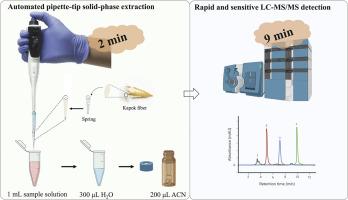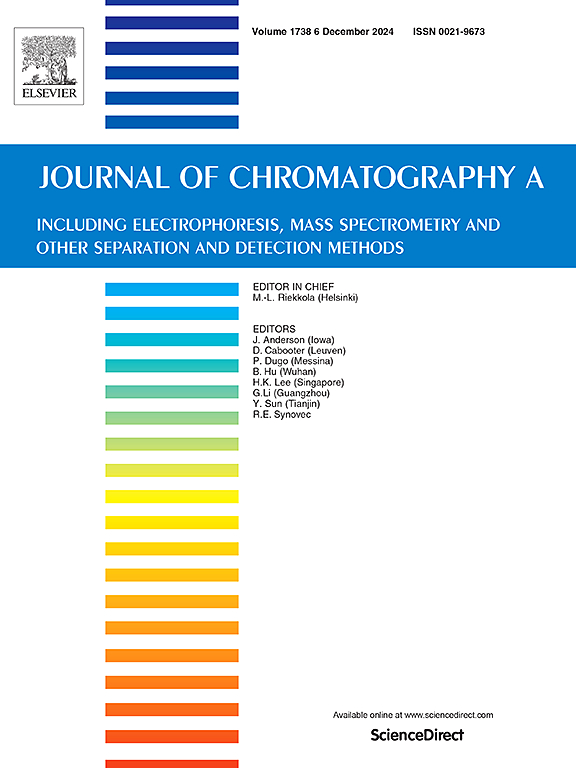Automated kapok fiber-based pipette-tip solid-phase extraction coupled with liquid chromatography-tandem mass spectrometry for rapid and sensitive analysis of tyrosine kinase inhibitors in plasma
IF 3.8
2区 化学
Q1 BIOCHEMICAL RESEARCH METHODS
引用次数: 0
Abstract
This study delineates the development of a novel automated pipette-tip solid-phase extraction (SPE) methodology, employing kapok fiber as a naturally efficient and cost-effective adsorbent for the selective extraction of eleven tyrosine kinase inhibitors (TKIs) from plasma. The uniqueness of this method lies in its assembly, where kapok fibers are ingeniously wrapped around a stainless-steel spring within the pipette tip, ensuring an obstruction-free central space for effortless solution aspiration and dispensation. This design significantly minimizes backpressure, enhancing operational efficiency and ensuring compatibility with pipettors, including the implementation of an electric pipettor to streamline the sample preparation process and facilitate automation. The method's analytical performance, rigorously validated through liquid chromatography-tandem mass spectrometry, exhibits outstanding linearity in ranges of 0.1/0.5–200 ng mL-1 (R² > 0.993), commendable accuracy (86.3%–114.8%), and consistent precision (3.4–11.3%), alongside remarkably low detection limits that span from 0.024 to 0.130 ng mL-1. The assembly of kapok fiber within the pipette tip, in this unique configuration, results in a practical, cost-effective, eco-friendly, and automated pipette-tip SPE method. This innovation signifies a significant advancement in bioanalytical methodologies, offering an efficient and sustainable approach for extracting analytes from complex biological samples. This process notably enhances both the sensitivity and selectivity of subsequent instrumental analyses.

基于卡波克纤维的自动吸头固相萃取与液相色谱-串联质谱联用技术,用于快速灵敏地分析血浆中的酪氨酸激酶抑制剂。
本研究描述了一种新型自动吸头固相萃取(SPE)方法的开发过程,该方法采用木棉纤维作为一种天然高效且经济实惠的吸附剂,用于从血浆中选择性萃取 11 种酪氨酸激酶抑制剂(TKIs)。这种方法的独特之处在于其组装方式,即在移液器吸头内的不锈钢弹簧上巧妙地缠绕木棉纤维,确保中央空间畅通无阻,使溶液的抽吸和分配毫不费力。这种设计大大降低了背压,提高了操作效率,确保了与移液器的兼容性,包括采用电动移液器来简化样品制备过程和促进自动化。该方法的分析性能经过液相色谱-串联质谱法的严格验证,在 0.1/0.5-200 纳克毫升-1(R² > 0.993)的范围内具有出色的线性度、值得称道的准确度(86.3%-114.8%)和一致的精密度(3.4%-11.3%),同时检测限也非常低,从 0.024 纳克毫升-1 到 0.130 纳克毫升-1。在移液器吸头内装配木棉纤维的这种独特配置,可实现实用、经济、环保和自动化的移液器吸头 SPE 方法。这一创新标志着生物分析方法的重大进步,为从复杂的生物样品中提取分析物提供了一种高效、可持续的方法。该工艺显著提高了后续仪器分析的灵敏度和选择性。
本文章由计算机程序翻译,如有差异,请以英文原文为准。
求助全文
约1分钟内获得全文
求助全文
来源期刊

Journal of Chromatography A
化学-分析化学
CiteScore
7.90
自引率
14.60%
发文量
742
审稿时长
45 days
期刊介绍:
The Journal of Chromatography A provides a forum for the publication of original research and critical reviews on all aspects of fundamental and applied separation science. The scope of the journal includes chromatography and related techniques, electromigration techniques (e.g. electrophoresis, electrochromatography), hyphenated and other multi-dimensional techniques, sample preparation, and detection methods such as mass spectrometry. Contributions consist mainly of research papers dealing with the theory of separation methods, instrumental developments and analytical and preparative applications of general interest.
 求助内容:
求助内容: 应助结果提醒方式:
应助结果提醒方式:


